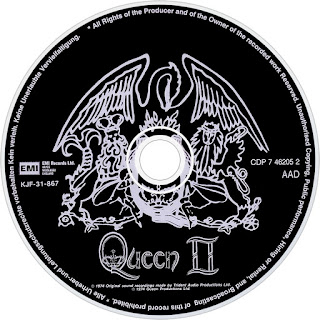Queen II is the second studio album by the British rock band Queen. It was released on 8 March 1974 by EMI Records at midnight in the UK and by Elektra Records in the US. It was recorded at Trident Studios and Langham 1 Studios, London from February to August 1973 with co-producers Roy Thomas Baker and Robin Cable, and engineered by Mike Stone. The album is notable for its combination of a heavy rock sound with an art rock sensibility. It has been called "a pillar of grandiose, assaultive hard rock" by the Rock and Roll Hall of Fame.
Queen II is not a concept album but a collection of songs with a loose theme running throughout. The two sides of the original LP were labelled "Side White" and "Side Black" (instead of the conventional sides "A" and "B"), with corresponding photos of the band dressed in white or in black on either side of the record's label face. The white side has songs with a more emotional theme and the black side is almost entirely about fantasy, often with quite dark themes. Mick Rock's album cover photograph was frequently re-used by the band throughout its career, including the music videos for the songs "Bohemian Rhapsody" (1975), and "One Vision" (1985).
Released to an initially mixed critical reception, Queen II remains one of the band's lesser-known albums. Nonetheless, the album has retained a cult following since its release, has garnered praise from other musicians such as Axl Rose, Steve Vai and Billy Corgan, and is significant in being the first album to contain elements of the band's signature sound of multi-layered overdubs, vocal harmonies, and varied musical styles.
After their self-titled debut album Queen was recorded and mixed by the end of November 1972, Queen set about touring and promoting it. Management problems forced the album to be released on the independent Trident label, but only after eight months had gone by since completion. During that time, Queen were writing new material and eager to record it. Several new songs were written immediately after the first album, and some dated from even earlier. "See What a Fool I've Been" was left over from the Smile days. "Ogre Battle" was written during the debut album sessions, as was "Father To Son", but the band decided to wait on recording them until they had more freedom in the studio.
August 1973 found the band back in Trident Studios, now allowed to book proper hours there, with an album under their belts. For what is generally considered a complex album (with layered vocals, harmonies and instruments), it took a very short time — only one month — to record Queen II. A full version of "Seven Seas of Rhye" was laid down, recorded with the specific intention of being the album's leading single. After the commercial failure of "Keep Yourself Alive", which was taken from the first album, Queen decided it needed a single that did not take "too long to happen" (without a lengthy guitar intro). So, Queen and Baker made sure that "Rhye" began in a way which would grab people. Mythology and art were passions of Mercury's, and Richard Dadd's painting The Fairy Feller's Master-Stroke (which currently hangs in the Tate Gallery) sparked his creativity. This scene from Dadd's imagination was inspired by characters from fairy myths, which in the painting are gathered around the Feller of Trees to watch him crack a walnut for Queen Mab's new carriage.
Rock photographer Mick Rock was employed to do the photography for the album's artwork. This single picture of Queen, used on the Queen II album cover, would become one of the band's most iconic images, revisited and brought to life for the "Bohemian Rhapsody" promotional film. Robin Cable, with whom Mercury had worked during the "I Can Hear Music" session, was recruited to reproduce the Spector production sound for "Funny How Love Is".
The "White" side is very diverse: four of the five numbers were composed by Brian May, where one is instrumental, one is sung by Freddie Mercury and Roger Taylor (with May at the piano), the next is sung by Mercury, and the last by May. The closing track of The "White" Side is Taylor's only composition in the album, which he also sings. John Deacon played acoustic guitar on "Father to Son" in addition to normal duties on bass guitar.
Lead singer Freddie Mercury composed the entire "Black" side, contributing piano and harpsichord pieces and a wide range of distinctive vocal performances.
The Queen II album cover features a photograph taken by Mick Rock of, according to VH1, "Queen standing in diamond formation, heads tilted back like Easter Island statues" against a black background. The band had hired Rock because they wanted to, in Rock's words, "graft some of [the trademark] decadent 'glam' sensibility" of his work with artists such as David Bowie, Iggy Pop and Lou Reed. Subsequently, the brief the photographer received from Queen was to have a black and white theme for the Queen II artwork. According to Rock, the group were looking to grab people's attention with the cover, especially since their first album had failed to do so; "They realised that if you could catch people's eyes you could get them interested in music." Describing it as a "sort of a knockoff of an old Marlene Dietrich shot", the photographer took inspiration for the cover from a still of the actress from the 1932 film Shanghai Express. "And of course no one was ever more 'glam' than the divine Ms Dietrich", Rock quipped.
Although the band almost rejected the photograph because they felt it too pretentious, Rock convinced them otherwise; "It made them look like much bigger a deal than they were at the time, but it was a true reflection of their music." The image was reused by Queen for the promotional video of their 1975 single "Bohemian Rhapsody" and "One Vision" (1985).























No hay comentarios.:
Publicar un comentario